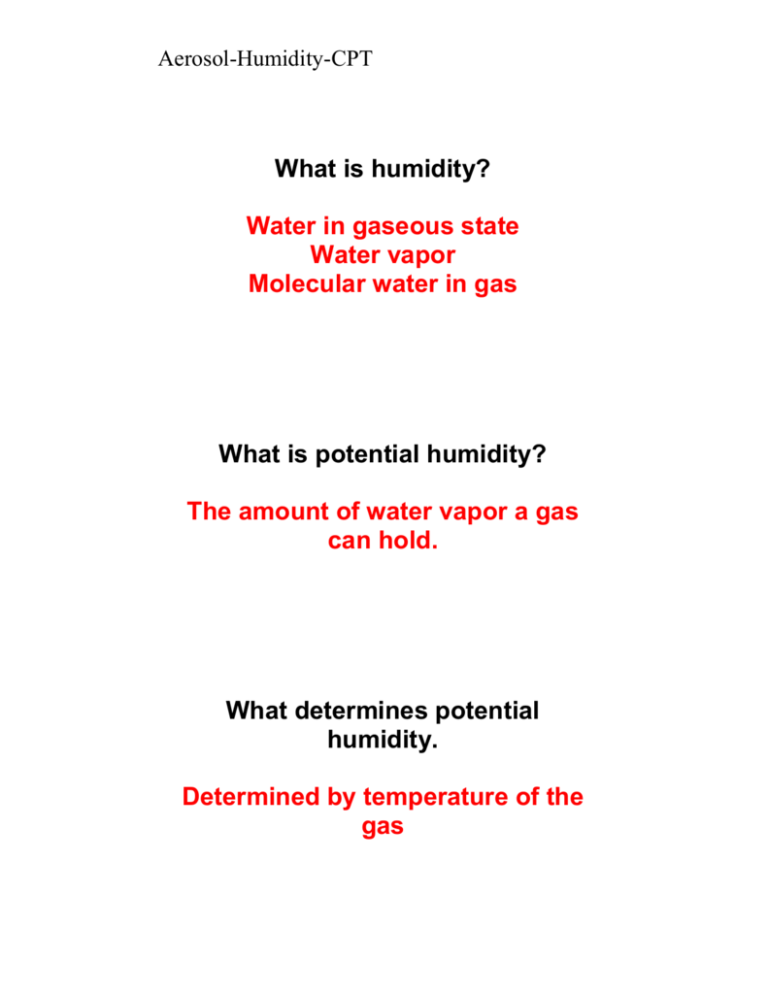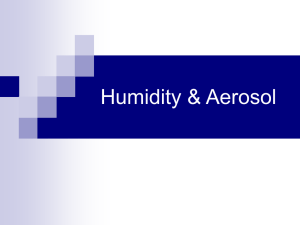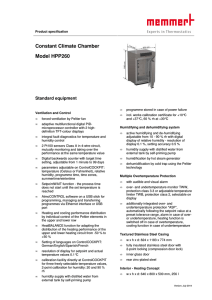TR Oral Flash Cards for Aerosol-Humidity-CPT
advertisement

Aerosol-Humidity-CPT What is humidity? Water in gaseous state Water vapor Molecular water in gas What is potential humidity? The amount of water vapor a gas can hold. What determines potential humidity. Determined by temperature of the gas Aerosol-Humidity-CPT In relation to humidity, define “saturated” When the gas has reached its potential at that temperature Define absolute humidity & how it is expressed. Amount of water weight held in the gas Expressed in mg/L What is the formula for relative humidity and how is it expressed? R.H. = Absolute humidity x 100 Potential humidity Expressed as a percent Aerosol-Humidity-CPT What is the relative humidity of alveolar gas? 100% Alveolar gas holds approximately how much water? 44mg/L at 37oC How much pressure is exerted by water vapor in alveolar gas? At 37oC and 100% R.H. the pressure exerted by water vapor is 47mmHg Aerosol-Humidity-CPT Define humidity deficit Amount of humidity in alveolar gas minus the amount of humidity inspired How is humidity normally supplied to inspired gas? By nasopharyngeal and oropharyngeal passages If humidity is not supplied by the normal routes, how will inspired gas obtain its humidity? Moisture will be taken from tracheal mucosal blanket which dries and thicken secretions Aerosol-Humidity-CPT What can inadequate humidification cause? Name 4. Decreased cilia activity Decreased movement of mucous Inflammation and necrosis of pulmonary epithelium Retention of secretions Bacterial culture media Atelectasis Pneumonia What are the 2 indications for humidification? To prevent dry gas from drying mucosa To provide near body humidity when upper airway function is impaired or bypassed True or False A humidifier delivers 100% R.H. at 30oC, therefore delivering 100% humidity to the patient. False – the temperature increases to 37oC at the patient. Less than 100% R.H. is delivered Aerosol-Humidity-CPT True or False If the temperature of a gas that has a RH of 100%, decreases, the RH will remain the same but the potential and actual humidity will decrease. False What is an Aerosol? Water particles suspended in air Particulate water in a gas Mist Fog What is “stability of an aerosol” The ability of particles to remain stable while suspended in a gas Aerosol-Humidity-CPT Name three factors affecting the stability of an aerosol Concentration Size Relative humidity How does concentration affect aerosol stability Number of particles – more particles will bump together and become larger and rain out How does particulate size affect aerosol stability? Large particles rain out Aerosol-Humidity-CPT How does relative humidity affect aerosol stability? Low relative humidity of the gas causes particles to evaporate With regard to aerosols, define penetration Depth within the tracheobronchial tree that a particle reaches In regards to aerosols, define deposition Particles will rain out at a particular area Aerosol-Humidity-CPT Name 4 factors influencing penetration and deposition of an aerosol Gravity Kinetic motion Inertial impaction Ventilatory pattern How does gravity influence the penetration and deposition of an aerosol? The larger (or more dense) the particle, the more likely it is to deposit or rain out How does kinetic motion influence the penetration and deposition of an aerosol? The more particles move, the more likely to bump together, coalesce and rain out Aerosol-Humidity-CPT How does inertial impaction influence the penetration and deposition of an aerosol? When airways narrow and alter direction, aerosol particles may continue on their same path and deposit by bumping into airway walls How does ventilatory pattern influence the penetration and deposition of an aerosol? Alterable factor Ideal pattern is slow, deep breath with an inspiratory hold Name 3 methods of clearing an aerosol from the lungs? Mobilization of the mucus blanket Cough Lymphatic uptake Phagocytes Mechanical suctioning Aerosol-Humidity-CPT What are the 4 indications of aerosol therapy? To thin secretions To improve cough To deliver medication Humidification of artificial airways Name 4 hazards of aerosol therapy Swelling of dried secretions Bronchospasm Fluid overload Nosocomial infection Aerosols can cause bronchospasm particularly in what type of patient? Pts with reactive airways Asthma Aerosol-Humidity-CPT With regard to humidifiers, what are the factors that influence RH? Surface area of exposure – the size of the bubble Time of contact – flow and depth of water Temperature Name 4 types of humidifiers. Passover Bubble diffuser or bubble type Jet Wick Membrane Heat & moisture exchanger How does a Passover humidifier work? Gas passes across surface of water. Water evaporates into the gas, increasing the humidity of gas Aerosol-Humidity-CPT Describe how a bubble humidifier works. Gas forced through a straw under water The smaller the bubbles, the greater RH The deeper the water, the greater the RH The higher the temperature, the greater the RH When is a bubble humidifier used? Used with cannula to prevent dry gas from being delivered At 37oC, what is the approximate RH of a bubble humidifier? Less than 40% Aerosol-Humidity-CPT How does a jet humidifier work? Uses the Bernoulli principle to draw gas up a tube Produces an aerosol that is baffled out to produce humidity Name three types of heated humidifiers? Cascade types Wick types Membrane types Heat & moisture exchangers How does a heated cascade type humidifier work? Can it deliver 100% body humidity? Uses a grid network to spread a thin layer of water, through which the gas passes before delivery to patient. Yes Aerosol-Humidity-CPT Describe how a wick humidifier works. At body temperature, how many mg/L of humidity can it deliver? Heater surrounds absorbent paper which soaks up water from the bottom of humidifier – gas passes warm wet paper and water is evaporated – water level is maintained constant by a feed apparatus. 44mgL Describe how the artificial nose works and when it should be used. Passive humidifier – captures heat and moisture for exhaled gas and returns them to pt on next inspiration Short term use with normal body temperature and minimal secretions Name 3 types of nebulizers Jet Babbington or hydrosphere Ultrasonic Spinning disk Aerosol-Humidity-CPT Name three types of jet nebulizers Large reservoir Small volume (standard jet) Mainstream nebulizer Sidestream nebulizer On what principle are jet nebulizers based? Bernoulli principle How are jet nebulizers powered? Pneumatically powered Aerosol-Humidity-CPT Describe what a large reservoir jet nebulizer is used for, its capacity, and its relative humidity range. For long-term nebulization Holds more than 250ml Deliver 50-75% RH Describe what the standard jet nebulizer is used for & its capacity. Used for IPPB Used primarily for delivery of medication Holds less than 20cc How does a mainstream nebulizer work? Gas flows directly through nebulizing chamber Aerosol-Humidity-CPT Describe the side stream nebulizer and the particulate size range. Aerosol is not created in main gas flow About 50% of particles in 1-5 micron size Describe the Babbington nebulizer and the particulate size rage. Based on Bernoulli principle – gas enters hollow glass sphere with hole in the side of it – film over port from dripping fluid on outer surface – gas exits ports in sphere – gas stream bursts film creating aerosol – produces a high volume aerosol – particles usually 3- 5 microns Describe the Ultrasonic nebulizer and the particulate size rage. Converts electrical energy into mechanical energy Uses a piezoelectric disc Frequency is predetermined by FCC Amplitude is adjustable & will alter output Has a high output (up to 6cc/min) 90% of particles 0.5 to 3 microns Aerosol-Humidity-CPT Describe the spinning disk nebulizer and the approximate RH delivered. Used as room humidifiers Uses a rotating platter Drips fluid onto the surface of the spinning platter Centrifugal force spins the fluid off the platter into the breaker combs, creating the aerosol stream Caution must be taken to avoid contamination Delivers approximately 25-75% RH What is the therapeutic range of an aerosol particle to reach alveoli? 1.0 – 3.0 microns What happens to particles smaller than the therapeutic range to reach the alveoli? Particles less than 1.0 microns are exhaled back out Aerosol-Humidity-CPT What happens to particles larger than the therapeutic range to reach the alveoli? Particles larger than 3.0 microns are deposited before reaching alveoli Name a potential hazard of an electrical nebulizer. Potential shock How would you position the patient to perform postural drainage on the apical segment of the right upper lobe? Semi-Fowler’s at 45 degree angle Aerosol-Humidity-CPT How would you position the patient to perform postural drainage on the anterior segment of the right upper lobe? Head of bed flat, patient supine How would you position the patient to perform postural drainage on the posterior segment of the right upper lobe? Head of bed flat, patient ¼ or higher from prone, right side up How would you position the patient to perform postural drainage on the medial segment of the right middle lobe? Head of bed down 12-14”, right side up, ¼ or higher supine Aerosol-Humidity-CPT How would you position the patient to perform postural drainage on the lateral segment of the right middle lobe? Right side up, head of bed down 1618 inches How would you position the patient to perform postural drainage on the superior segment of the right lower lobe? Head of bed flat, patient prone with pillows under abdomen How would you position the patient to perform postural drainage on the anterior basal segment of the right lower lobe? Head of bed down 18-20”, patient supine Aerosol-Humidity-CPT How would you position the patient to perform postural drainage on the lateral basal segment of the right lower lobe? Head of bed down 18-20”, pt lying right side up How would you position the patient to perform postural drainage on the posterior basal segment of the right lower lobe? Head of bed down 18-20”, patient prone How would you position the patient to perform postural drainage on the anterior segment of the left upper lobe? Head of bed flat, patient supine Aerosol-Humidity-CPT How would you position the patient to perform postural drainage on the apical-posterior segment of the left upper lobe? Head of bed up 30 degrees, patient left side up, ¼ or higher prone How would you position the patient to perform postural drainage on the superior lingula segment of the left upper lobe? Head of bed down 12-14”, patient left side up, ¼ or higher supine How would you position the patient to perform postural drainage on the inferior lingula segment of the left upper lobe? Head of bed down 12-14”, patient left side up, ¼ or higher supine Aerosol-Humidity-CPT How would you position the patient to perform postural drainage on the superior segment of the left lower lobe? Head of bed flat, patient prone with pillows under abdomen How would you position the patient to perform postural drainage on the anteriomedial segment of the left lower lobe? Head of bed down 18-20”, patient supine How would you position the patient to perform postural drainage on the lateral basal segment of the left lower lobe? Head of bed down 18-20”, patient left side up Aerosol-Humidity-CPT How would you position the patient to perform postural drainage on the posterior basal segment of the left lower lobe? Head of bed down 18-20”, patient prone Name 6 relative contraindications of Postural drainage? Empyema Head injuries Flail chest Unstable cardiac status Wounds COPD Spinal injuries Obesity Pneumothorax Pregnancy Recent meals or tube feeding What is percussion and when is it indicated? Clapping chest wall with cupped hands, relaxed wrist to set up vibrations to loosen secretions Indicated when difficult to mobilize secretions or when postural drainage alone may not be enough Aerosol-Humidity-CPT Name 6 relative contraindications of Percussion? Empyema Flail chest Wounds Frank hemoptysis Anticoagulant therapy Pain or pt intolerance TB Metastasized Cancer What are the instructions for performing percussion Avoid sternum, spine & bony structures May use sheet or towel to avoid slapping Examine skin for any effect Percuss each segment for 3-5 min Describe how a vibration is performed. Tense arms and keep them straight. Shake from shoulder during patient exhalation only. Aerosol-Humidity-CPT When is a vibration performed? In conjunction with percussion after each segmental percussion to move secretions to large airways Or alone when percussion is not tolerated Name 4 instructions on using mechanical percussors and vibrators. Only to lung area – avoid kidneys, etc. Avoid bony structures Avoid breast tissue in females Use towels or sheet to prevent slapping Use electrical precautions – avoid water; avoid hazardous gas environment Name some therapies used for bronchial hygiene other than CPT PEP – Positive Expiratory Pressure Flutter Valve High Frequency Chest Wall Oscillation Therapy Aerosol-Humidity-CPT What are the indications for PEP therapy? Aid in removal of retained secretions, Atelectasis, and treatment of Cystic Fibrosis What are the hazards of PEP therapy? Risk of barotraumas and homodynamic compromise What are the indications for Flutter Valve therapy? Aid in removal of retained secretions, Atelectasis, and treatment of Cystic Fibrosis Aerosol-Humidity-CPT What are the hazards of Flutter Valve therapy? Risk of barotraumas and homodynamic compromise What are the indications for High Frequency Chest Wall Oscillation therapy? Mucous plugging Retained secretions Treatment of Cystic Fibrosis What are the hazards of High Frequency Chest Wall Oscillation therapy? Unstable chest fractures may cause pneumothorax






